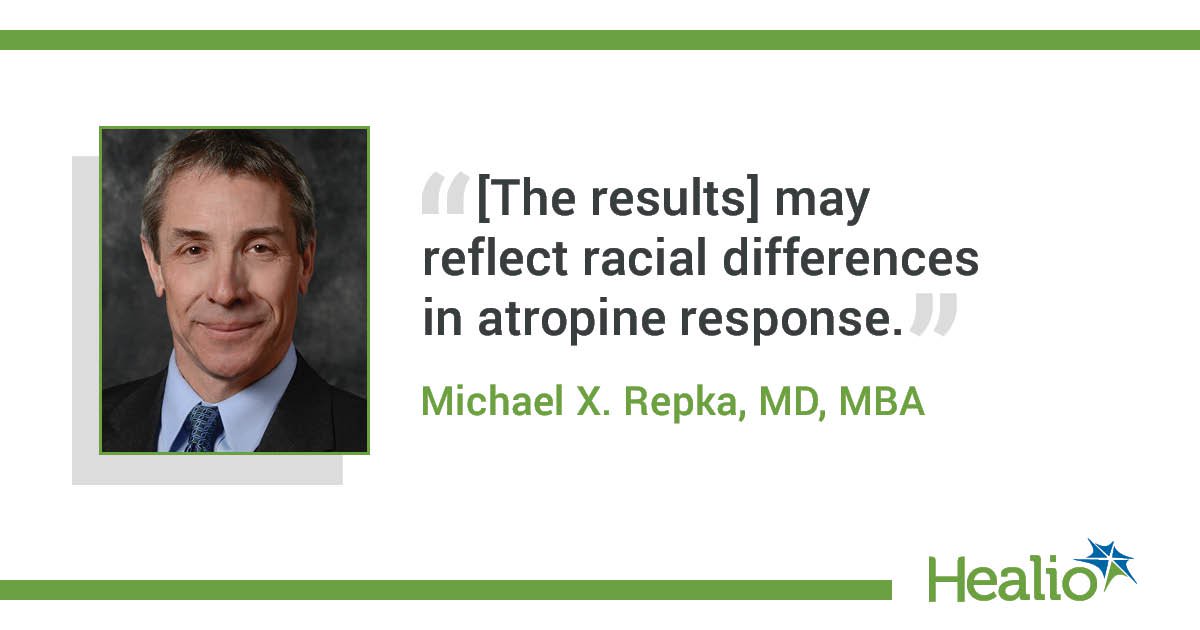Atropine drops fail to slow myopia in US children, study says
Key takeaways:
- Atropine eye drops had no effect on U.S. children’s myopia, unlike previous studies of Asian children.
- Atropine’s varying effects by dosage and race merit further study.
Two years of nightly atropine eye drops did not slow myopia progression or axial elongation in a cohort of U.S. children compared with placebo, according to a randomized clinical trial.
The results contradict those of previous studies in Asian ethnicities and call for further studies evaluating genetic factors, higher atropine doses and a host of other variables, Michael X. Repka, MD, MBA, vice chair for clinical practice at Wilmer Eye Institute and professor of ophthalmology at Johns Hopkins University, and colleagues wrote in JAMA Ophthalmology.

“It’s possible that a different concentration of atropine is needed for U.S. children to experience a benefit,” the study’s other lead co-author, Katherine K. Weise, OD, MBA, FAAO, director of pediatric optometry and professor at University of Alabama at Birmingham, said in a related press release from the National Eye Institute. “Clinical researchers could evaluate new pharmaceuticals and special wavelengths of light in combination with optical strategies, like special glasses or contact lenses, to see what works in reducing the progression of myopia.”
The multicenter, placebo-controlled trial enrolled 187 children aged 5 to 12 years with between –1 D and –6 D spherical equivalent refraction (SER). They were randomly assigned in a 2:1 ratio to either nightly 0.01% atropine eye drops (n = 125) or placebo (n = 62).
Forty-six percent of participants were white; 18% were Black; 16% were Hispanic or Latino; 14% were East, South or West Asian; and 6% were multiracial.

At 24 months, there was a difference of 0.02 D between the two groups’ adjusted mean changes in SER from baseline. The atropine group’s change was –0.82 D, and the placebo group’s change was –0.80 D.
Both groups also saw similar changes in axial length: an adjusted mean change from baseline of 0.44 mm in the atropine group and 0.45 mm in the placebo group.
After 6 months without treatment, another round of follow-up found adjusted mean SER changes from baseline of –0.94 D in the atropine group, with a standard deviation of 0.77, and –0.88 D in the placebo group, with a standard deviation of 0.71. Mean axial length change from baseline was 0.51 mm in the atropine group, with a standard deviation of 0.35, and 0.49 mm in the placebo group, with a standard deviation of 0.32.
Most participants in both atropine and placebo groups reported at least one ocular adverse event, most of which were considered mild, according to the study.
The researchers identified two limitations to their study: They lacked an objective measure of eye drop use due to reliance on family self-reports, and refractive error could not be measured during some follow-ups due to COVID-19 shutdowns.
The researchers noted that “the absence of a benefit” from 0.01% atropine eye drops was consistent across subgroups of age, sex, race and ethnicity, eye color and baseline SER.
The finding diverges from the results of five clinical trials — from Singapore, Hong Kong, Japan, India and China — that achieved varying reductions in myopia progression following atropine drops, researchers wrote.
They suggested several possible reasons. In two of the Asian studies, researchers lacked contemporaneous placebo control and lost some participants over the course of follow-up. Repka and colleagues also highlighted studies finding that atropine reduces myopia progression at higher doses, such as 0.025% or 0.05% concentrations.
A previous study from Australia, with similar criteria and ethnic composition to the U.S. study, found atropine to be of even less benefit, yielding an adjusted mean SER change of 0.14 D at 2 years, researchers noted.
The mixed results between ethnicities also “may reflect racial differences in atropine response,” Repka said in the press release, noting that “the study enrolled fewer Asian children, whose myopia progresses more quickly, and included Black children, whose myopia progresses less quickly compared with other races.”
Future studies should focus on testing “increased atropine concentrations, new pharmaceuticals, objective measures of treatment adherence, alternative eye drop delivery systems and schedules, as well as evaluating the impact of environmental and genetic factors and optical interventions on myopia control treatment,” researchers wrote.
Reference:
- Very low-dose atropine eye drops no better than placebo for slowing myopia progression. https://www.nei.nih.gov/about/news-and-events/news/very-low-dose-atropine-eye-drops-no-better-placebo-slowing-myopia-progression. Published July 13, 2023. Accessed July 18, 2023.

